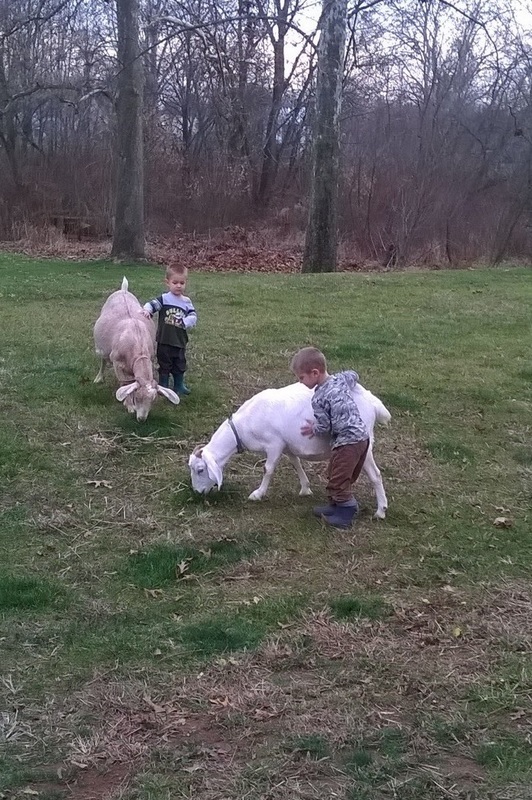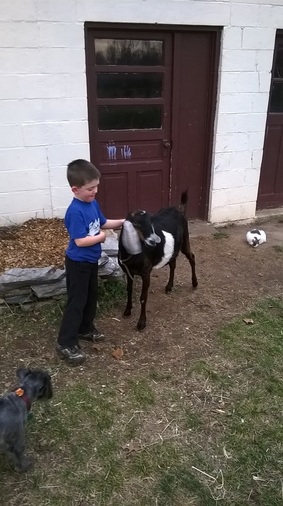|
I found myself googling the title of this blog frequently since we’ve bought goats in 2013. By googling that phrase, you will learn about several methods to attempt to evaluate if your goat is expecting, all with varying degrees of expense and accuracy.
If you aren’t a dairy goat person, you may wonder why it is such a big deal whether or not a goat is expecting. Just wait the 5 month gestation and see! The reason it is a concern to us is that some breeds of goats are seasonal breeders, which means they only go “into heat” in the fall of the year. So, couple that fact with the 5 month gestation, and if you adopt the wait-and-see approach, by the time you’ve waited and seen, it is now spring and not a great time to breed your goat. Another reason it is of concern to goat breeders is that goats need to be dried up at least 2 months before kidding. We prefer to dry them up prior to breeding. If the goat is dry, that means no milk and no profit. Raising goats is NOT a lucrative past time; therefore, you want to know that you are not feeding and housing an open goat. The first year we had goats, we went by wait-and-see until about month before they were due. Suddenly the suspense got to us, and we really wanted to know if we should cancel some upcoming plans that we had to be at home for kidding. So, we called our vet to perform an ultrasound. Yes, a goat ultrasound with equipment designed for a horse, but it still gave us enough information to know that our goats were, in my vet’s words, open. Open for breeding, that is. We were very disappointed. We had a lot invested in these goats – fencing, time, feed, time, vaccinations, time, etc. We soon learned that the buck we had used only produced kids at one of the four farms he visited that fall. So, we were left with hope that our goats could indeed be bred in the coming fall. But we were still milkless. That is what prompted us to buy a goat in milk, our dear Vanilla. Fast forward to the fall of 2014 when we had 3 goats to breed. We went with another buck. A proven buck this time. Because we felt confident it the buck, we decided to just wait and see. This time, it worked! Each of does had kids in the spring of 2015. We were hoping to use the same approach in 2015, but the buck passed away unexpectedly two days before coming to our farm. That prompted us to purchase a buckling to use for breeding. Using a buckling (any buck under one year of age) for breeding has several advantages and disadvantages, but that’s topic for another post. We observed our new buckling, Prince, carefully. He certainly seemed to know what to do, but how could we know for sure if our goats were pregnant? Here are the options we had. 1. Wait & See – While this approach is the cheapest up front, it is very costly if the goat is not bred. Since we were using an unproven young buckling, we knew the chance of him not being fertile and capable was there. 2. Blood test – There is a blood test called BioPRYN that measures the presence of a pregnancy-specific protein. It is only accurate 30 days after breeding. The cost of this test through a local lab is only $3.65 a goat. However, the cost of getting our vet to draw blood is $24 a goat, bringing the cost to $27.65 per goat. 3. Bounce test – You can find youtube videos on this. Basically, you stand behind the goat and wrap your arms around their abdomen and gently bounce up to feel for kids. This is also suggested to do when a goat in labor has had one or two kids, and you are wondering if there are more. The problem with this test is that is very subjective, and if you only have a handful of goats, it is difficult to get the different feels of who is pregnant and who isn’t. 4. Ultrasound – As I mentioned previously in this post, a vet can perform a goat ultrasound. It will cost you roughly $50-75 per goat. Our vet suggested waiting until they are about 2 months pregnant. After much deliberating, we decided to have our vet come out and draw blood to complete the BioPRYN test for pregnancy. One of the reasons we chose the blood test is that we also wanted to test our goats for CAE (Caprine Arthritis Encephalitis-in my vet's words, "the goat AIDS"), which is done through a blood test as well. All that leads me to announce, that, YES, our goats are pregnant! Russell Homestead is officially expecting goat kids in the end of February 2016! Our goat kids make great home milkers or pets. This year, we used a polled buck, which means a percentage of our kids will likely be polled (naturally won’t have horns). Those with horns will be disbudded. We are asking $150 for does and $125 for bucks. None of goat kids this year are registered, but they are almost 100% Nubian blood. Contact us to be put on our waiting list. We are also exploring the possibility of offering a limited amount of goat shares. Please contact us for details.
2 Comments
|
AuthorVanessa from Russell Homestead. Follower of the Lord Jesus, wife of my knight in shining armor, mother of 5 wonderful children, and joint-keeper of the Russell homestead. Thanks for stopping by! Archives
March 2023
Categories
All
Vanessa Russell
Independent Field Representative ID#20249934. |


 RSS Feed
RSS Feed